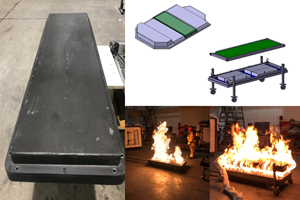Cure for cratering: Gel coat perfected with design of experiments software
Resin manufacturer Interplastic Corp. – Thermoset Resins Div. (St. Paul, Minn.), a major gel coat producer, recently developed a new gel coat with the aid of Design-Expert design of experiments software from Stat-Ease Inc. (Minneapolis, Minn.).
Resin manufacturer Interplastic Corp. – Thermoset Resins Div. (St. Paul, Minn.), a major gel coat producer, recently developed a new gel coat for open molding, but initial testing showed problems with cratering, the formation of holes in the gel coat’s surface. Craters can form because the gel coat lacks the proper surface tension balance, which causes the coating to be repelled by certain areas of the mold.
Scott Crump, Interplastic’s technical director, was tasked with devising an experimental strategy to optimize the proportion of each ingredient of the formulation with respect to cratering and other key quality parameters. Normally such experiments are designed as a process of small and sequentially executed steps, based on repeated induction/deduction cycles that use information gained to optimize the responses in each ongoing step. This is a traditional approach in specialty chemical product development; it also is a very difficult one because gel coat comprises an intricate and interactive blend of polymer, additives, fillers/pigments and reactive diluents. And the already complex gel coat formulation is complicated further by the fact that there are literally hundreds of ingredients available to adjust performance, and these can be combined in an infinite range of proportions.
“This approach is too slow,” says Crump, “particularly when we are faced with the challenge of developing a new product quickly to meet an urgent market need.” Moreover, if one ingredient is increased proportionally to solve a problem, another problem can easily arise.
That’s why Crump elected to use design of experiments (DOE) to identify the optimal proportion for each ingredient and measure the robustness of candidate designs. DOE drastically reduces the number of runs required to determine the optimum value of each factor by varying the values of all factors in parallel. This approach determines not just the main effects of each factor, but also the interactions among the factors, and it also requires far fewer experimental iterations than the traditional progressive optimization approach.
To carry out DOE, Crump used trademarked Design-Expert software from Stat-Ease Inc. (Minneapolis, Minn.) and selected the software’s D-optimal “mixture design” because it provided the minimum number of blends to fit a given predictive model.
“Design-Expert focuses exclusively on DOE,” says Crump. Intended for use by subject matter experts rather than statisticians, the software walks the user through the process of designing and running the experiment and then evaluating the results. The experimental design was appropriate for modeling three factors at four or five levels each. Design-Expert created a 31-run experiment with 28 unique gel coat blends and three replicates. The use of a mixture design experiment reduced the number of runs required to achieve the desired level of accuracy by 50 percent compared to a traditional experimental setup (the replicated runs were used to quantify the noise in the results). Chemists prepared blends for each of the runs based on the concentrations of each ingredient selected by the software.
Each gel coat formulation was sprayed onto a panel with surface properties that matched a typical open mold. Experts examined and rated each panel with respect to cratering, dimpling and sagging. All three issues were evaluated simultaneously to avoid the possibility of selecting a blend that would fix the cratering but create another problem. Crump developed a “desirability function” that weighted the response variables to produce a single number that represented the overall quality of the formulation. A response surface map was used to visualize the desirability function as an outcome of the three factors. The areas of highest quality on the map are indicated by red. Chemists ran confirmatory experiments at the optimal value, and the results closely matched the DOE prediction.
“Manufacturing startup went very well because we had mapped out the formulation space and selected a very robust formulation,” Crump reports. “Stat-Ease helped us to achieve an exceptionally high level of quality with this product, which has been very well received by our customers and is a resounding success in the market.”
Related Content
Price, performance, protection: EV battery enclosures, Part 1
Composite technologies are growing in use as suppliers continue efforts to meet more demanding requirements for EV battery enclosures.
Read MoreCycling forward with bike frame materials and processes
Fine-tuning of conventional materials and processes characterizes today’s CFRP bicycle frame manufacturing, whether in the large factories of Asia or at reshored facilities in North America and Europe. Thermoplastic resins and automated processes are on the horizon, though likely years away from high-volume production levels.
Read MorePlant tour: Joby Aviation, Marina, Calif., U.S.
As the advanced air mobility market begins to take shape, market leader Joby Aviation works to industrialize composites manufacturing for its first-generation, composites-intensive, all-electric air taxi.
Read MoreThermoplastic composites welding advances for more sustainable airframes
Multiple demonstrators help various welding technologies approach TRL 6 in the quest for lighter weight, lower cost.
Read MoreRead Next
Composites end markets: Energy (2024)
Composites are used widely in oil/gas, wind and other renewable energy applications. Despite market challenges, growth potential and innovation for composites continue.
Read MoreCW’s 2024 Top Shops survey offers new approach to benchmarking
Respondents that complete the survey by April 30, 2024, have the chance to be recognized as an honoree.
Read MoreFrom the CW Archives: The tale of the thermoplastic cryotank
In 2006, guest columnist Bob Hartunian related the story of his efforts two decades prior, while at McDonnell Douglas, to develop a thermoplastic composite crytank for hydrogen storage. He learned a lot of lessons.
Read More


























